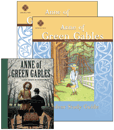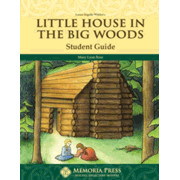Memoria Press has developed literature study guides for all grade levels. Sets of guides and books/novels for each grade level challenge students to read slightly above grade level. These sets are designed to complement a classical education. (Memoria Press has also developed complete grade-level programs for the elementary grades into which these sets are incorporated.)
First-grade literature guides differ from those for the other grades. For first grade, there are only two guides, each of which covers five and seven children's books respectively. Among books read for first grade are Caps for Sale, Make Way for Ducklings, Billy and Blaze, Keep the Lights Burning Abbie, and The Little House. The guides are titled StoryTime Treasures and More StoryTime Treasures. Each study guide serves as a student workbook with activity sheets for working on vocabulary, comprehension, and other reading skills, as well as some introductory grammar. This does not replace core instruction in grammar and composition.
For second grade and beyond, there is a separate student study guide for each novel, except for the collection of four smaller books by Beatrix Potter covered by a single guide. Second-grade titles in addition to the Beatrix Potter collection are The Courage of Sarah Noble, Little House in the Big Woods, Animal Folk Tales of America, and Prairie School. For both first and second grade there is a single Teacher Key covering all books for that grade. The Teacher Keys have only the answers and do not reprint pages in the student study guides, so you need both guides and the Teacher Key.
The format changes for grades three through seven with separate student study guides and Teacher Guides for each book. The Teacher Guides reproduce student pages but have answers overprinted. Guides and novels for each grade level are:
- Grade three: Farmer Boy, Charlotte's Web, Mr. Popper's Penguins, and A Bear Called Paddington
- Grade four: The Cricket in Times Square, Homer Price, The Blue Fairy Book, and Dangerous Journey
- Grade five: The Lion, the Witch, and the Wardrobe; Heidi; and Lassie Come-Home
- Grade six: Adam of the Road, The Door in the Wall, Robin Hood, and King Arthur
- Grade seven: The Trojan War, Anne of Green Gables, The Bronze Bow, and The Hobbit
- Grade eight: The Wind in the Willows, Treasure Island, As You Like It, and Tom Sawyer
- Grade nine: Beowulf, the Warrior; Sir Gawain and the Green Knight; The Canterbury Tales, and Henry V
- Grade ten: Romeo and Juliet, The Scarlet Letter, Macbeth, and Pride and Prejudice
- Grade eleven: The Divine Comedy
- Grade twelve: Hamlet, Anna Karenina, A Tale of Two Cities, and King Lear
High school students might use the listed books or substitute others, such as The Great Gatsby, Hard Times, Little Women, Jane Eyre, Robinson Crusoe, A Midsummer Night's Dream, The Merchant of Venice, Julius Caesar, and Greek Tragedies (with videos).
Guides differ in content according to levels. I reviewed the Anne of Green Gables Teacher Guide by Eric Knight. Study guides work primarily on vocabulary and comprehension while helping students develop a love for good literature.
The Anne of Green Gables Teacher Guide suggests several options for vocabulary study. Students can underline unfamiliar words in the novel as they encounter them. and then look them up. The guide has an appendix with a list of vocabulary words with brief definitions that students might use. Students should write these definitions in a notebook. After every five lessons, students have another opportunity to test their mastery of the vocabulary with a crossword puzzle; puzzles also serve as quizzes. Vocabulary words might also be used on spelling tests or as copybook exercises. In addition to these options, each lesson has six fill-in-the-blank exercises for students to study words in context and come up with synonyms that might replace them. (The vocabulary list and definitions in the appendix might be used for this too.)
At first glance, the guides look like simple activity books, but they include suggestions for other activities such as those described above that broaden the ways students might learn.
“Expressions for Discussion” in each lesson are about a half dozen brief passages selected from the book for discussion. Anne of Green Gables is a perfect book for this type of exercise because there are so many “expressions” such as “There is no scope for imagination in it at all.” The Appendix includes a page of Scripture and Shakespearean references in Anne of Green Gables (and where they appear in the novel) that should enhance the study; some of these references show up in lesson questions, but some do not. You might want to bring up those that don't on your own for discussion.
Comprehension questions might be discussed orally, but they also work well as written exercises for students to answer in complete sentences or paragraphs. Each lesson concludes with one or two optional “Honors” activities. Some poems included in the Appendix are used with some of the Honors assignments. In addition to poetry study, Honors activities include research, writing, memorization, copybook work, and drawing.
A mid-term and final review are used along with the crossword puzzles for assessment. Suggested answers for lessons and reviews are included where they are appropriate in the Teacher Guide. Quite a bit of writing is required by this Guide, so it might also serve as your source for composition assignments.
The novel Anne of Green Gables revolves around Christian themes to some extent, and the Guide reflects that rather than being a Christian study of the book.
Guides may be purchased individually or as grade-level sets. Novels are also available from Memoria Press.













